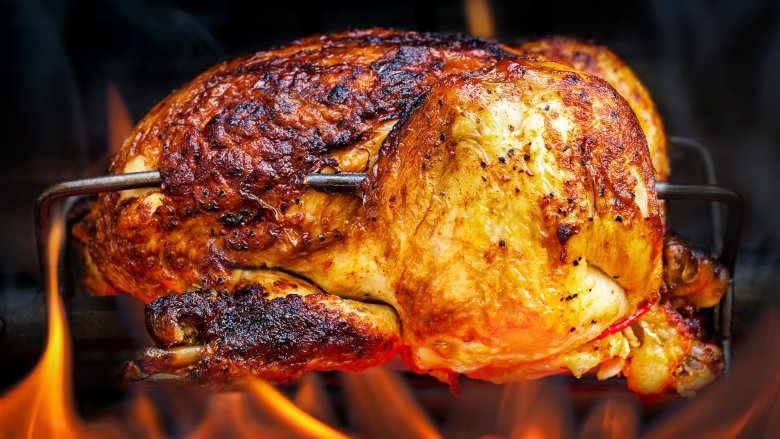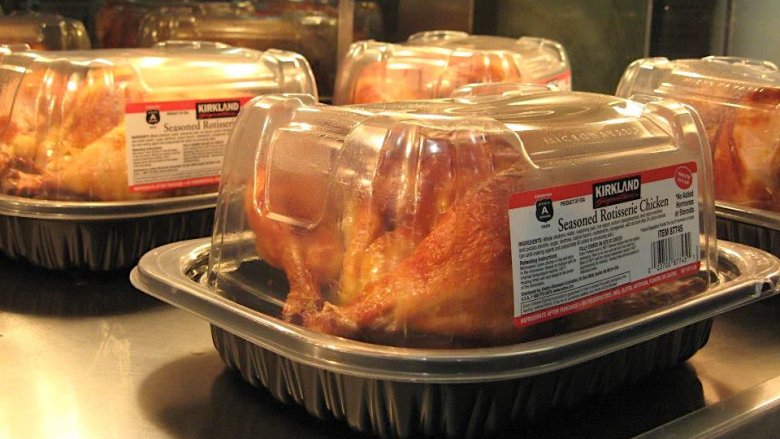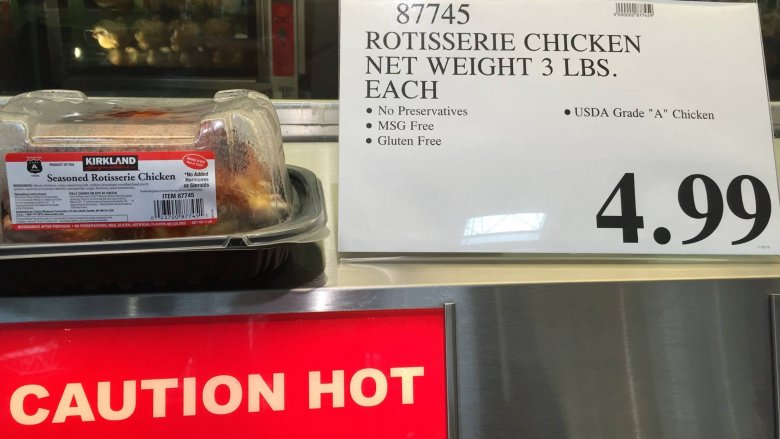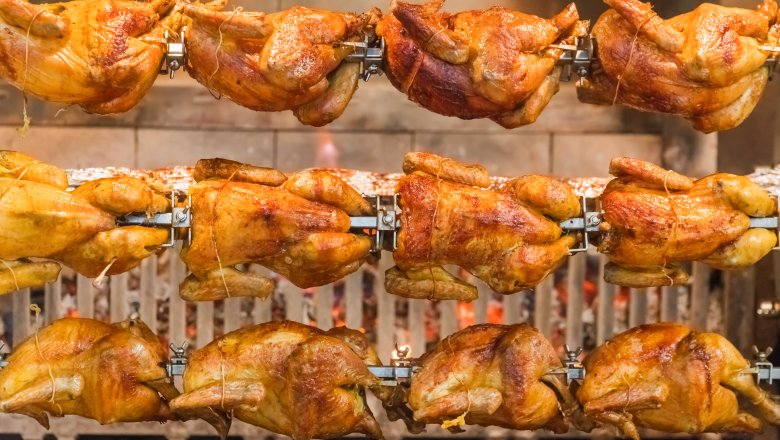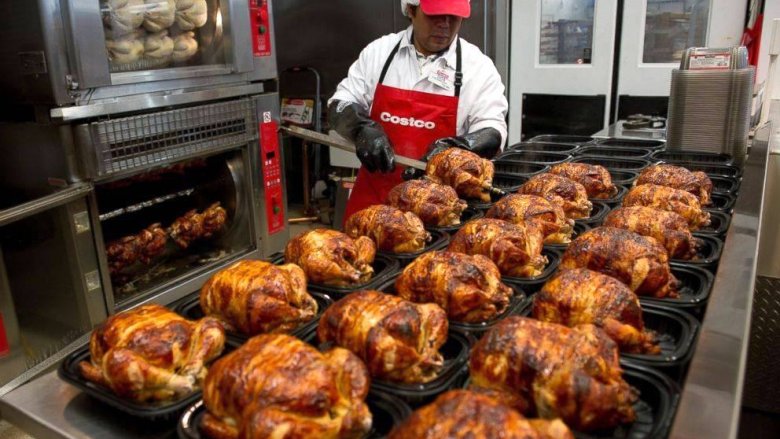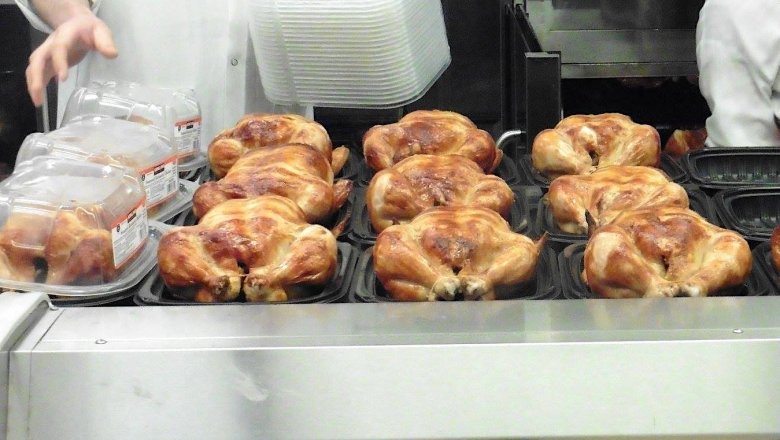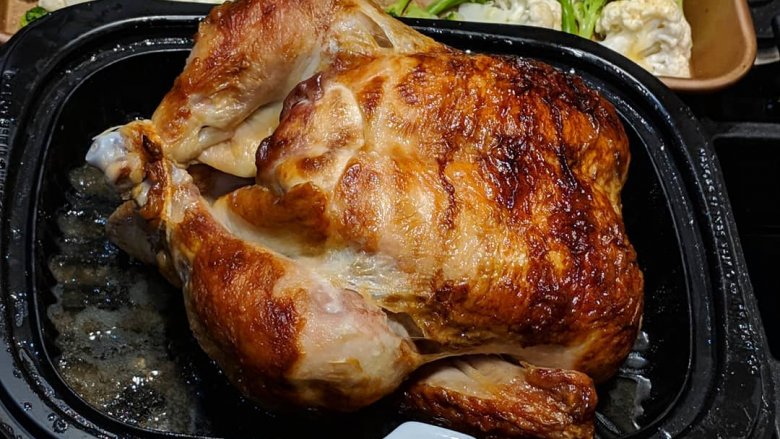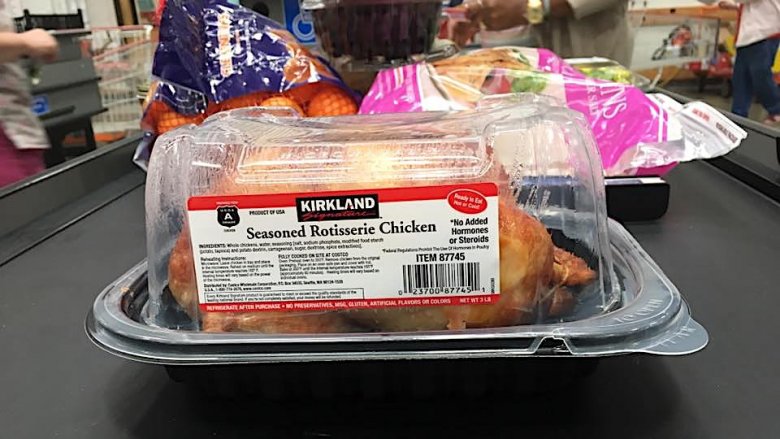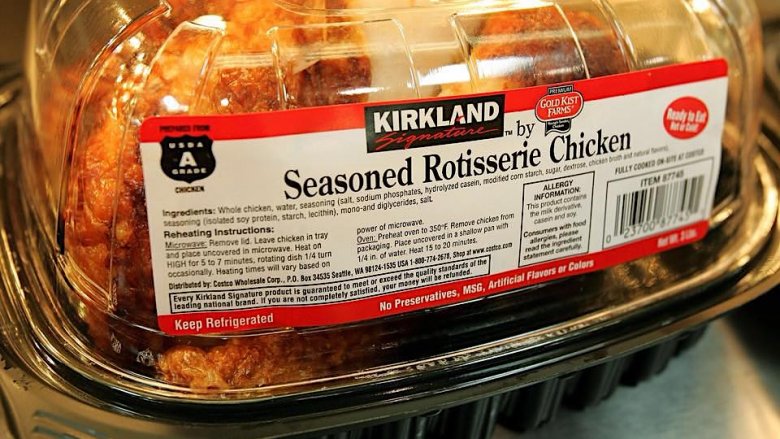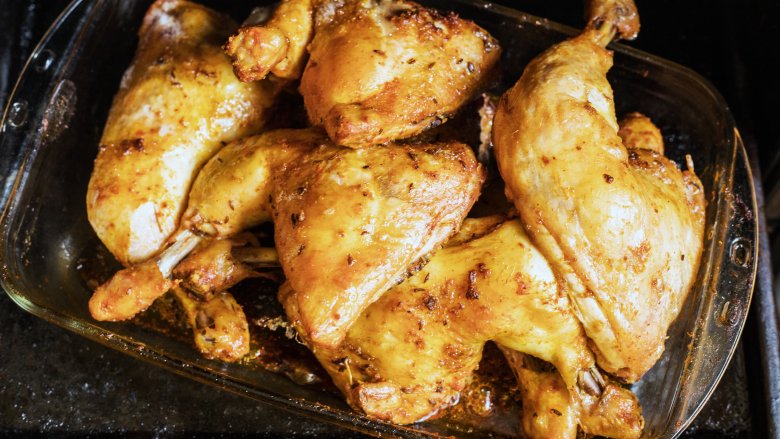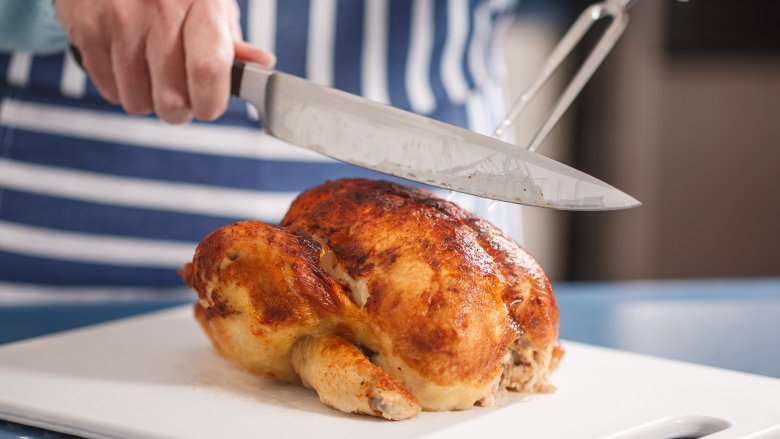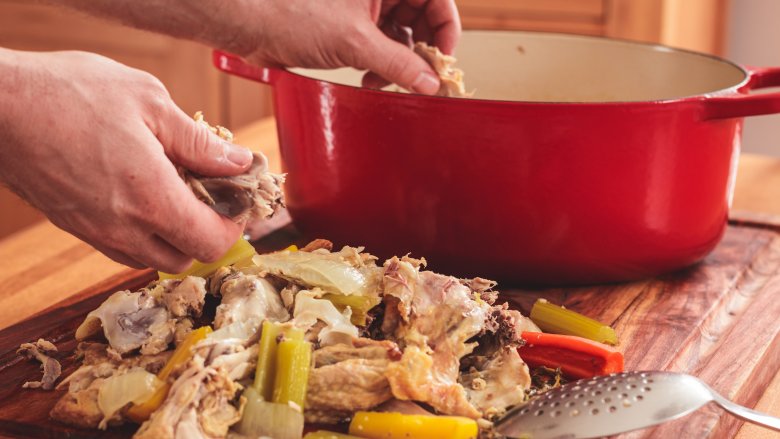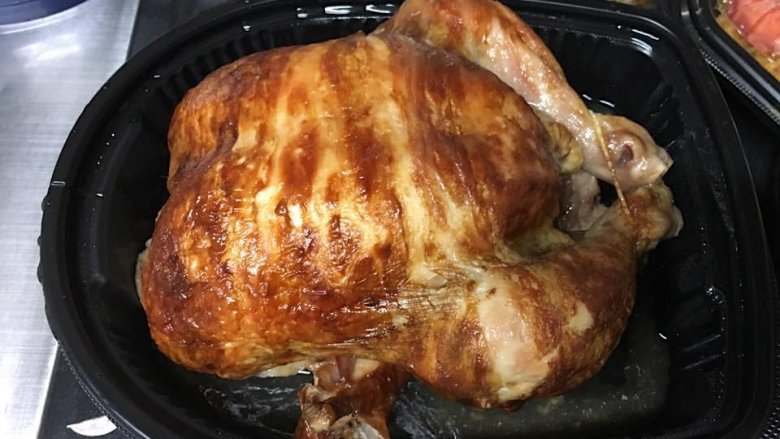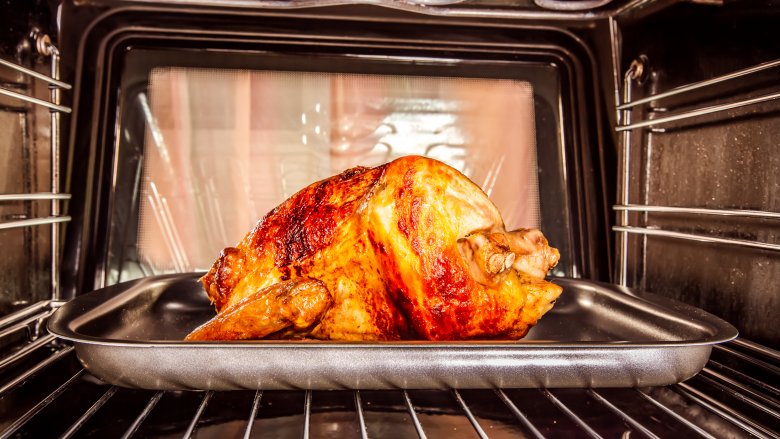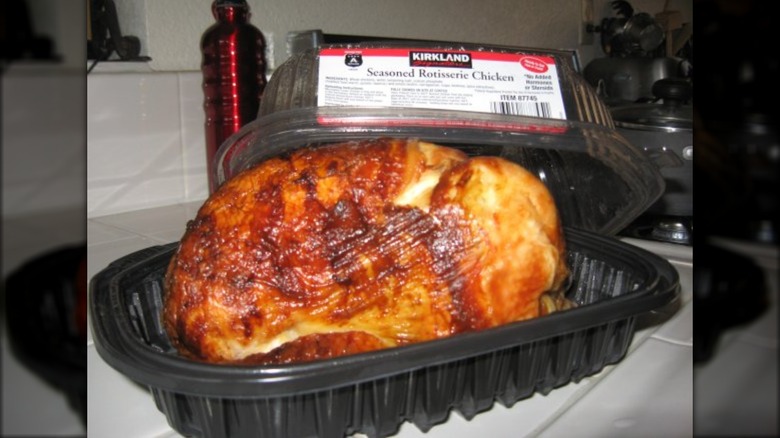Read This Before Buying Costco's Rotisserie Chicken
Chances are good that even if you're not a card-carrying Costco member, you've heard plenty about their rotisserie chicken, and if you are a card-carrying member of the warehouse store, chances are even better that you've bought one (or 100). They're hard to resist as an easy weeknight dinner for the family, or, you know, a midnight snack for one.
Don't believe they're all that hard to resist? Costco sold more than 64 million of these bad boys in fiscal year 2018 in the U.S., which means warehouse stores across the country are processing 179,000 rotisserie chickens every single day. If that's not proof of their popularity, we don't know what is.
But for as much as you've heard, or for as many as you've bought, there is undoubtedly plenty that you don't know about this spit-roasted delight. And since knowledge is power, we're here to fill you in on everything you need to know about Costco's rotisserie chickens before you buy one (or before you buy your next one) — from what's really in them, to how they stack up to competition, to what to do with it once you get it home.
What's actually in a Costco rotisserie chicken?
If you've had just one bite of Costco's rotisserie chicken, you probably assume that they're injecting it with unicorn tears and magical seasonings, because not only is it impossibly tender, but it also scores a 10/10 on flavor, too. So what exactly goes into it?
It turns out that no unicorns were harmed in the making of the chicken, and the ingredient list is actually pretty simple: Whole chicken, water and seasonings (salt, sodium phosphate, modified food starch, potato dextrin, carrageenan, sugar, dextrose, spice extractives). Sure, you might furrow your brow at a few of those words, but there's nothing too terribly scary here. Sodium phosphate is an additive that helps keep meats moist, and maintains freshness. Modified food starch is an additive typically used for thickening, stabilizing, or emulsifying. Potato dextrin is a thickener and a sweetener, but can also be used to enhance crispness in foods. Carrageenan — an additive and preservative that, in chicken, helps to retain water — is probably the most controversial ingredient here. Though it's FDA-approved, there is some evidence to suggest that it triggers negative health effects in some. And dextrose is a simple sugar made from corn.
For the most part, it seems these additives ensure maximum tenderness, and provide that always-winning combo of salty/sweet goodness. All in all, you probably eat plenty of foods with way scarier labels that don't taste anywhere near as good as Costco's rotisserie chicken.
What's not in a Costco rotisserie chicken?
Did you notice that the ingredient list of Costco's rotisserie chicken is missing something that's typically pretty common among other grocery store rotisserie chickens? Look again. You'll find no MSG (monosodium glutamate) there.
Although MSG tends to get a bad rap, there's no doubt that it makes food taste amazing with all its umami-enhancing abilities. But that's neither here nor there, because Costco's chicken just doesn't need it to taste amazing. (And plus, let's be honest, there's plenty of salt and sodium and sugar in that seasoning blend already. Adding MSG to the situation would be what we call an embarrassment of riches in the flavor department.)
Another thing you don't have to worry about with Costco's rotisserie chicken? Gluten. A company representative confirmed that these bad boys are gluten-free, which, like the use of MSG, is not always the case with grocery store rotisserie chickens.
Costco's rotisserie chicken has a lot of sodium, but maybe not as much as you think
If there's one knock on any brand of rotisserie chicken, it's the high sodium content. And yes, Costco's does come packed with its fair share, but it's certainly not the worst.
Bonnie Taub-Dix, RDN, told Today that a 3-ounce serving of rotisserie chicken can have as much as 600 milligrams of sodium. Good news, Costco fans — the same serving size of their rotisserie chicken comes in at 460 milligrams (or about 5.5 milligrams of sodium per gram of chicken), compared to Sam's Club's rotisserie chicken at 550 milligrams. Can you find tasty rotisserie chicken with less sodium? Sure, Publix's, for example, has just 2.9 milligrams of sodium per gram of chicken... but the question is, does it taste as good?
Since we don't tend to think twice about sodium when we're taking down a fast food hamburger, let's take a peek a McDonald's Double Quarter Pounder with Cheese, shall we? 1,310 milligrams. How about a Wendy's Baconator? 1,630 milligrams. According to the FDA, the recommended daily value of sodium is less than 2,300 milligrams. So, you can have five servings of Costco's rotisserie chicken, or, you know, one Baconator. Those sodium-packed chicken options are looking pretty good right now, aren't they?
As long as we're talking nutrition, here's what else you get with that 3-ounce serving of Costco rotisserie chicken: 140 calories, 7 grams of fat, and 19 grams of protein.
Costco's rotisserie chicken gives you a lot of bang for your buck
You go to Costco for one thing: great deals on supersized products. And you should expect no less with Costco's rotisserie chicken. For the bargain-basement cost of $4.99, you get a monster of a bird whose price and weight beat the pants off competitors' offerings.
Coming in at a weight of at least 3 pounds cooked, Costco's rotisserie chicken dwarfs those sold by other stores. According to The Wall Street Journal, a 1-1/2 to 2-pound bird is what you'll typically find elsewhere, and you'll pay up to $7 for it (unless you're shopping at Whole Foods, then you'll pay $10). You don't need to be a math whiz to see that paying $5 for a 3-pound chicken is better than paying $7 for a 2-pounder.
Not only is it a steal for its size, but Costco typically ranks number one in rotisserie chicken taste tests, which is completely unsurprising if you've ever had even one bite. Whether it goes up against Sam's Club, Walmart, Kroger, or Whole Foods, Costco is tops.
What we're saying is, in the case of Costco's rotisserie chicken, the old adage "you get what you pay for" definitely does not apply.
How to pick the best Costco rotisserie chicken
When it comes to Costco's rotisserie chicken, you know you're going to get a seriously hefty bird no matter which one you choose, but you still want to pick the best, freshest one possible, and once you know what to look for, it's easy.
Bon Appétit's senior food editor Rick Martinez says that picking the heaviest bird also means picking the freshest, because a heavier chicken indicates that its juices haven't yet evaporated under those heat lamps. "You'll feel a noticeable difference between the birds that just came out of the oven and ones that have been sitting there all day," he explains. The skin also tells a tale. You want evenly browned and taut skin, because, Martinez says, "As the juices leave the meat, the chicken's skin begins to shrivel and becomes discolored."
A former Costco meat department manager shared another useful tip on Reddit, advising, "...look for ones that touch the top of the lid, they weigh the most."
One more tip: Grab your Costco rotisserie chicken at the end of your shopping trip. We all know how easy it is to get lost in the maze of aisles that make up that heavenly warehouse store, and for safety's sake, the USDA recommends that cooked food be refrigerated within two hours to prevent bacteria growth.
Don't expect your Costco rotisserie chicken to have crispy skin
If you've never had the pleasure of experiencing the deliciousness of a Costco rotisserie chicken, there's one very important thing you need to know ahead of time so your hopes and dreams aren't dashed when you take your first bite: The skin will almost certainly not be crispy.
Maybe if you waited at the flaming wall o' chickens, and ate the skin off the bird the second it was pulled off the spit... maybe then it would be crispy. But as it is, after it's roasted to tender perfection, that rotisserie chicken gets placed into its plastic container, waiting to go home with you, and by the time it makes its journey to your kitchen, that skin is more soggy than crisp. Now don't get us wrong — it's still utterly delicious, and you will definitely have to restrain yourself from stripping each and every last bit of salty, brown skin off in one sitting. Addictive and unbelievably tasty, yes, but definitely not crispy.
Be prepared to spend a lot more than $4.99 on that Costco rotisserie chicken
Costco's rotisserie chickens are well-known as a loss leader, which is defined as merchandise "sold at a loss in order to draw customers." In other words, Costco is willing to sell those chickens at $4.99, even if they're not making any money on them, because chances are good that you're not making the trek to the warehouse store for one single chicken.
Even if you think you're just going to run in, grab a hot rotisserie chicken, and beeline it to the registers, how often does that really happen? You remember that you're almost out of laundry detergent, or you see pair of designer jeans that you totally don't need but are so cheap you have to have them, or you get suckered into buying a 36-pack of sausages because the sample was that good. Nine times out of 10, you're leaving Costco with a whole lot more than that $4.99 rotisserie chicken, and a whole lot less money in your wallet. Costco might be willing to sell you a delicious chicken for under $5, but they're certainly not doing it out of the goodness of their heart.
Buying Costco's rotisserie chicken means more waste than some competitors
Costco's rotisserie chickens, like plenty of other grocery stores' chickens, come packaged in a plastic clamshell. You probably don't give too much thought to the packaging — it seems like a fairly logical and inexpensive way to get that steaming hot chicken from the warehouse store to your kitchen. But it turns out there is another option, and the alternative uses a lot less plastic than those clamshells.
In May 2019, The Takeout reported that Whole Foods would be selling their rotisserie chickens in bags rather than hard plastic clamshells, a move, the company says, that along with other packaging changes "will reduce an estimated 800,000 pounds of plastic per year." Wegman's had already made the change to selling their rotisserie chickens in pouches, and say they use 75 percent less plastic than the standard domes.
With 64 million Costco rotisserie chickens sold each year, you can imagine how much plastic waste all those clamshells add up to, because unfortunately, they're not recyclable everywhere. Does this mean you shouldn't buy rotisserie chickens from Costco? That's for you to decide.
You might be able to score leftovers super cheap
Is there anything better than a $4.99 Costco rotisserie chicken fresh-off-the-spit? Well, it depends how you feel about bargains. You're in for the steal of the century if you're willing to forgo that steaming hot whole chicken.
According to deal-seeking Redditors, at some Costco locations, unsold rotisserie chickens are chilled and repurposed into packs of eight leg quarters (the thigh and drumstick) for $4.99. Yes, the same price as a whole chicken. Think about it: Eight leg quarters would easily yield more meat than a whole chicken — the only thing you're missing is two breasts and two tiny wings, after all, and six (six!) additional thighs and drumsticks will more than make up for that. Plus, you get all dark meat.
In-the-know Redditors advised that certain times are better than others to score this deal, saying that early mornings are best, and particularly Tuesday through Friday, because the chickens have a greater chance of selling out on the weekends, meaning there are no leftovers to be sold.
There's a hack for breaking down your Costco rotisserie chicken fast
Want to get the most meat off your Costco rotisserie chicken? According to Rachael Ray Every Day, "It's all about that wishbone, baby."
We all know that Rachael Ray, the mastermind behind the publication, is the reigning queen of 30-minute meals, and she's probably never met a pre-cooked rotisserie chicken she didn't like... which is precisely why we should trust this hack. Not only does it mean breaking down your rotisserie chicken will be easier, but it also means that you'll walk away with more meat.
It turns out that the wishbone is good for more than making wishes once you've carved your bird — pulling it out before you start to carve is the key to success. The publication describes the simple three-step process, saying, "Feel for the Y-shaped wishbone between the neck and the breast. Make a small cut behind the bone and then use your fingers to loosen it from the flesh. Run your fingers along the backbone and under the breast meat to remove the breast in one piece." That's it. You'll save time and spare yourself the aggravation of wrestling with the carcass to get every last scrap of breast meat off. Win, win.
You shouldn't toss the carcass from that Costco rotisserie chicken
Stock recipes typically call for the bones and scraps leftover after breaking down raw chicken. But if you're not using the carcass from your Costco rotisserie chicken to make your stock, you're missing out.
According to Bon Appétit, when you use the bones from an already-roasted bird, you'll actually be left with a darker stock than from raw chicken, which ultimately means more flavor will be added to whatever dish you use the stock in. The process for making stock with pre-cooked rotisserie chicken is the same as using raw chicken parts — just add water, vegetables (like carrot, onion, and celery), and aromatics (like herbs and garlic), then simmer for an hour or more and strain.
While spending the time to make stock from a convenience item like rotisserie chicken might seem like a lot of work, think about it this way: You paid just $4.99 for that bird, which is a steal to begin with, and now for a few pennies worth of veggies you're also getting a pot of rich, dark stock out of it. Isn't that worth the trouble?
How much meat can you expect from a Costco rotisserie chicken?
So you want to take advantage of the convenience and ease of Costco's rotisserie chicken — it's a great idea for a dinnertime shortcut, and we're definitely not judging. But the problem is, your recipe calls for a certain amount of meat and you have no idea how much a rotisserie chicken will actually yield once you get it off the bone. Spoiler alert: It's a lot.
According to Betty Crocker, the average rotisserie chicken is about 2 pounds, and will yield 3 cups of meat (2 cups white, 1 cup dark), which translates to about 1 pound. But we already know that Costco's rotisserie chickens are substantially larger than the average bird, so how much can you expect from them? Food blogger @judyschickens broke down two Costco chickens and got a whopping 5 pounds out of them, about 2-1/2 pounds from each (over 7-1/2 cups total). Not to state the obvious, but that's a lot more than your standard rotisserie chicken, and should be plenty for whatever recipe you've got in mind.
The best way to reheat a Costco rotisserie chicken
There's no worse sin than taking a perfectly cooked rotisserie chicken, bringing it home and sticking it in the refrigerator until dinnertime, and then completely ruining it when you reheat it. All that beautifully tender meat gets turned into chicken-flavored shoe leather after a couple minutes in the microwave. But there's good news: There is a way to successfully reheat your Costco rotisserie chicken without rendering it inedible.
According to Elana Karp, head chef and culinary co-founder at Plated, you've got to use the oven for best results, but the key is adding some liquid to the situation. Grab a high-sided baking dish, plop that rotisserie chicken inside, and pour about 1/4-inch of chicken stock into the dish. Reheat the chicken at 400 degrees until the stock is bubbling and the chicken is warmed through. Karp promises that the liquid will ensure a moist reheated bird, as opposed to using a dry heat or the microwave. It takes a little more time, but you'll be glad you exercised a little patience.
Some customers have complained that the chicken has chemical taste
Pretty much everyone agrees that $4.99 for a whole chicken is a delicious deal. But for a number of Costco shoppers, the retailer's rotisserie chicken has been leaving them with nothing but a bad taste in their mouths.
These customers have claimed that their Costco rotisserie chickens taste off. The topic has been the subject of at least two separate Reddit threads. The first originated in May 2022 with one Redditor commenting, "Chemically tasting rotisserie chicken — totally freaked out!!" Another agreed, claiming her Costco chicken "tasted like it was dipped in some sort of cleaner." In early 2023, a similar thread popped up with a Redditor asking simply, "What's up with the rotisserie chicken lately?" They claimed to have eaten two Costco rotisserie chickens over the previous three weeks, both of which had what they described as a "distinct chemical taste." Another user concurred, comparing the taste to chlorine.
Maybe the most convincing piece of evidence came from a Redditor who often feeds the chicken to their cat. "I have an elderly cat who, for quite a long time, insisted on rotisserie chicken as her primary sustenance," they wrote. "One day I brought home a fresh one and she completely refused it after smelling what was in her dish. Thinking that maybe it was just the one chicken, I bought her another, and then another, and she won't touch any of it." When in doubt, trust your animal's instincts.
